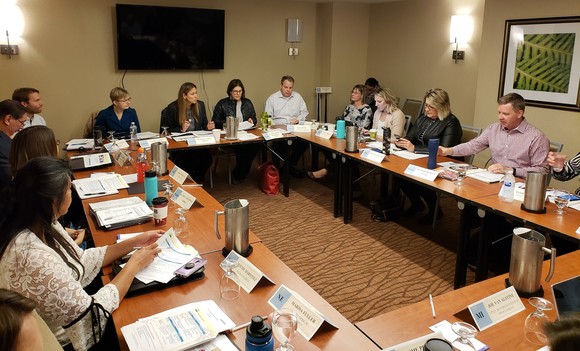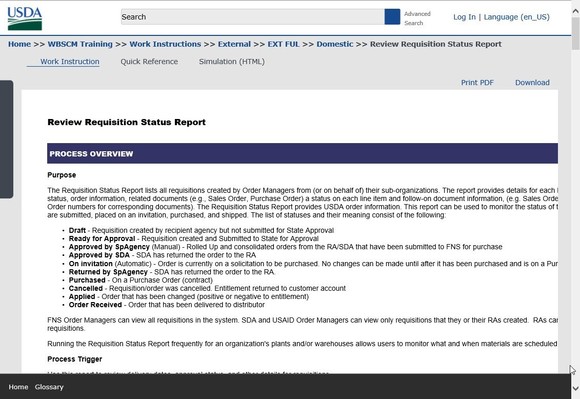FDPNE Grant Application Open
The Request for Applications (RFA) for the Fiscal Year 2019 Food Distribution Program on Indian Reservations Nutrition Education (FDPNE) Grant is now open on Grants.gov! Click here to view details about this grant opportunity. The FDPNE grant funds projects that provide nutrition information and services to FDPIR participants, helping the organizations that serve this population find new ways to aid their constituents. Indian Tribal Organizations (ITO) and State agencies that are current FDPIR allowance holders (have a direct agreement with FNS to administer FDPIR) are eligible to apply. You can read about projects funded in last year's grant program here.
The application deadline is April 30 at 11:59 p.m. Eastern Time. Interested applicants are encouraged to carefully read the RFA and application and ensure they submit all the requested forms and information. The Related Documents tab on Grants.gov includes the RFA and supporting documents such as a sample project timeline, sample budget narrative, and match calculator to help with the application process.
Interested in learning more? Visit the FDPNE webpage to read about this year's grant opportunity and projects funded in previous years.
Nutrition education can include providing cooking demos, taste tests, recipes, or healthy eating tips to participants of all ages. In this photo from Spirit Lake Sioux Tribe in North Dakota, children learn how to make colorful fruit kebabs.
FDPIR Monthly Distribution Guide Rate Update: Option to Exchange Juice for Fruit
The Food Distribution Program on Indian Reservations (FDPIR) Monthly Distribution Guide Rate was recently updated and includes significant changes to the fruit category. On March 1, 2019, the fruit and juice categories were combined into one category to provide participants with greater variety and flexibility. This change allows participants to take up to 20 units of canned, fresh, frozen, or dried fruit and juice per person per month. Participants now have the option to select more fruit if they do not want their selection of juice.
The following Guide Rates apply to the newly combined fruit and juice category:
- One bottle of juice (64 oz.) equals 5 units
- A limit of 2 bottles of juice (10 units) per person per month
- No limit on canned/fresh/dried fruit selection up to the maximum guide rate (20 units)
- Participants may select all units as fruit if they wish
- Participants may continue to exchange 1 can of fruit for 1 pound of fresh fruit
- Participants may continue to exchange 1 pound of vegetables for 1 pound of fruit up to 5 pounds of fruit per person per month
Learn more about which fruits and juices are offered by downloading a copy of the latest FDPIR Monthly Distribution Guide Rate.
Frozen Blueberries

Frozen blueberries (110623) were recently added to the FDPIR Foods Available List! This item will be available in a 2.5 pound bag and will count as 3 units in the newly consolidated Fruit and Juice category. Blueberries are packed with nutrients like antioxidants and fiber and are a healthy addition to any meal. Frozen blueberries can be thawed in the refrigerator or used frozen. This versatile fruit can be baked in breads, muffins, or used as a topping for oatmeal or cereal.
|
Produce Seasonality
The USDA DoD Fresh Fruit and Vegetable Program (USDA DoD Fresh) provides FDPIR participants the option to receive U.S. grown, fresh, high quality fruits and vegetables as part of the monthly food package. ITOs that choose to participate in USDA DoD Fresh place orders in the Fresh Fruits and Vegetables Order Receipt System (FFAVORS) catalog for produce items that recipients want. The catalog may include any produce item listed in Exhibit O, FDPIR Monthly Distribution Guide Rates. This list was updated in March to identify which produce items are available year round and those that are available seasonally.
If a seasonal fruit or vegetable item is not listed in the FFAVORS catalog, the ITO should contact the produce vendor and the Defense Logistics Agency (DLA) Representative to ask if the item is available. The availability of produce depends on location, growing conditions, weather, and domestic availability. DLA contracting must also approve that the price of the item is fair and reasonable.
The ITO is responsible for inspecting the produce at the time of delivery. Warehouse staff should be trained on how to properly accept and inspect produce. Reject produce if it is not U.S. grown or is poor quality. Any issues (e.g. shortage/overage, poor quality and condition) should be documented on the Bill of Lading (BOL).
Be sure to report any issues to the vendor, DLA Representative, and the FNS Regional Office. We understand that documenting and reporting each complaint takes time and effort, but documentation is needed for DLA to take action when a vendor is not meeting contract requirements.
If the vendor does not promptly address the issue or the issue continues, the complaint should be reported to: USDADoDFresh@usda.gov. FNS will work with DLA to ensure that the vendor promptly addresses complaints.
When reporting a USDA DoD Fresh complaint, include the following information:
- Inspect all produce at the time of delivery. Document the date and time of delivery and note if the truck was refrigerated.
- Examine the produce quality and condition. Condition defects include bruising, sunken discolored areas, shriveling, discoloration, and decay.
- At the time of delivery, reject produce if it is not U.S. grown or is poor quality.
- Verify the quantity received matches the quantity ordered in FFAVORS by comparing the order in FFAVORS with the BOL. Note any discrepancies in FFAVORS.
- Document all issues on the delivery document (BOL), before the driver leaves.
- Take clear photos of any issues. Include a photo of the carton label and of any poor quality produce.
- Keep copies of the BOL for your records.
For more information on receiving USDA DoD Fresh Produce, please view our “Best Practices” webinars, available on the Webinars and Training Page.
New Resources on the FDPIR Sharing Gallery
The FDPIR Sharing Gallery is a source of inspiration and sharing of nutrition education materials, recipes, photos, grant opportunities, and more for Indian Tribal Organizations participating in FDPIR. New items are added when they become available, and program operators and nutrition educators are always welcome to send their materials and suggestions to USDAFoods@fns.usda.gov! Check out these recent additions to the Nutrition Education, Grant Opportunities, and Digital Resources sections:

-
American Indian Traditional Foods in USDA School Meals Programs: A Wisconsin Farm to School Toolkit provides tips on using traditional foods in school meals and includes recipes and a cycle menu. The toolkit is available on the Wisconsin Department of Public Instruction’s Farm to School Traditional Foods webpage, which also features nutrition education videos highlighting common, traditional foods in Wisconsin.
- The Second Edition of the Physical Activity Guidelines for Americans provides evidence-based recommendations for youth ages 3 through 17 and for adults to safely get the physical activity they need to stay healthy. The Move Your Way Campaign offers tools and resources such as fact sheets, posters, and videos to promote and share key messages from the Physical Activity Guidelines.
-
Free Tribal Grant Writing Training and Resources from the Association of American Indian Physicians include a variety of downloadable resources and video lectures about the grant writing process, as well as train-the-trainer materials.
- The Centers for Disease Control and Prevention (CDC) Grant Writing Resources for Tribes site provides information on CDC funding opportunities for Tribes and Tribal Organizations along with tips and resources for the grant writing process.
- The CDC Success Stories Portal features the Success Stories Application, a free, online tool to help you share the story of how your funding is used and why your work matters. Features include professionally designed templates and free photos, as well as guidance on how to adapt your story for a variety of audiences, from partners to funders. Visit the Success Stories Library for inspiration and to view examples of what other communities are doing to make healthy living easier!
- FDPIR Photo Album: Seminole Nation of Oklahoma showcases the grocery store model where FDPIR participants can select the items in their monthly food packages. Seminole's store also features colorful signage reinforcing healthy eating messages and shelving with the traditional name of the food.
|
The Year Ahead in FDPIR Food Package Activities
On November 14 and 15, 2018, members of the FDPIR Food Package Review Work Group met in Alexandria, Virginia, for their yearly strategic meeting. The two-day meeting covered a variety of topics centered on making changes to the food package to include new foods, guide rate changes, and a larger discussion on nutrition education opportunities and resources. This year, food package participants will be receiving a sampling of dried cranberries along with the new permanent inclusion of frozen blueberries and a boneless, skinless chicken option among their food choices. Work Group members also focused discussion on a priority list of USDA Foods, including traditional foods, and voted to continue purchases of wild salmon, wild rice, and catfish as traditional offerings along with bison and blue cornmeal which are permanent items in the food package. Work Group members also agreed for USDA to research a lamb option this year as the next traditional food for FDPIR. USDA is currently conducting market research to determine the availability of lamb and later this year, the Work Group will vote on the options available. Among the Work Group members, the nutritionists on the team will be meeting to further discuss and recommend changes to categories to better meet the needs of program participants. Work Group members also discussed upcoming changes to the Automated Inventory System (AIS) used by FDPIR programs and partnership opportunities available through the Centers for Disease Control and Prevention (CDC).
 |
FDPIR Food Package Review Work Group Meeting in Alexandria, Virginia, November 2018.

Visiting Pueblo of Acoma
As you cross through the southwestern state of New Mexico, you arrive at a thriving food distribution program with a historical distinction as the oldest continuously inhabited community in North America. The Pueblo of Acoma operates the FDPIR serving approximately 278 participants monthly. The areas served by the Acoma Food Distribution Program include the Acoma and Laguna reservations, and the nearby towns of Grants, Milan, San Rafael, San Fidel, Cubero, and Seboyeta.
|

This program operates an impressive grocery store distribution model for clients to select food package items, offers weekly home-deliveries, and shares a catalog of creative recipes using USDA Foods, such as traditional prune pies, blue corn enchiladas, and fruit smoothies. The food distribution program staff incorporate traditional foods from the food package into cooking demonstrations at events such as community forums, Pueblo general meetings, and community feast days. These outreach activities have helped to increase monthly program participation. The enthusiastic and dedicated program staff ensure that participating households receive nutrition education along with their food package to help them maintain a nutritionally balanced diet. Thanks to Food Distribution Program Director, Connie Martinez, for sharing her program with us!
|
Connie Martinez, Food Distribution Program Director at Pueblo of Acoma
FFAVORS and WBSCM Login Help
During the registration process, FFAVORS and WBSCM users create login credentials in a separate system called eAuthentication. To recover forgotten information, self-service tools are available from the login screen via the “I forgot my User ID | Password” links, as shown below.
 To recover forgotten User ID(s), click on User ID. After entering your information, you will receive a list of any User ID(s) linked to this email.
To reset a forgotten Password, click on Password. You will be prompted to enter your User ID and answer the security questions you previously set up for your eAuthentication profile. After confirming your identity, you will be prompted to enter a new password. This action will also unlock your account if you had entered the wrong password too many times. Note: The Change my Password link can be used to update your account only if you know your current password.
If you have forgotten both your password and your security question responses:
-
Users with a LincPass (USDA-issued ID) should contact the eAuthentication Service Desk for assistance at 1-800-457-3642, option 1.
-
Users without a LincPass will need to reestablish access to FFAVORS or WBSCM with a new login ID. To update FFAVORS, contact the FFAVORS Help Desk. For WBSCM, contact the user administrator for your organization.
WBSCM Help Resources
The Web-Based Supply Chain Management (WBSCM) is under continuous improvement through monthly development activities. The March and April releases include improved training materials for:
- Create Multi-Food Order
- Create Domestic Requisition
- Modify Domestic Requisition
- Enter Domestic Shipment Receipt
- Upload Domestic Shipment Receipts
When logged in, users can access training materials through on-screen help while performing a transaction, by browsing the full library, or by performing a keyword search. A short tutorial, screen shown below, linked on the announcement banner at Help -> Welcome, provides an overview of WBSCM navigation and accessing help features.
 To browse training materials, go to Help -> Training and look through the categories, user groups, and functional areas or topics. Most documents will display in a separate window or tab, with options to download as PDF or other format(s), as shown below.
 Available resource types include:
-
Work Instruction – step-by-step instructions for common transactions, with optional screenshots and detailed field descriptions
-
Job Aid – general guidance and quick reference tools for working in WBSCM
-
Simulation – an audiovisual walk-through of a transaction, with option for interaction or view-only playback
-
Course Material – self-paced learning for a particular functional area and user group
-
Release Notes – summary of all changes introduced to WBSCM each month, including the impacted user groups and links to related training materials
Additional resources are available from the FNS webpage for WBSCM, including system and browser requirements, an FAQ, and examples and templates for uploading or downloading data from WBSCM.
For additional assistance, contact the WBSCM Service Desk or call (877) 927-2648.
USDA staff will be participating in this upcoming meeting in 2019. We look forward to meeting you and hope to see you there!
June 10-13: National Association of Food Distribution Programs on Indian Reservations (NAFDPIR) Annual Conference in Philadelphia, Mississippi.
|